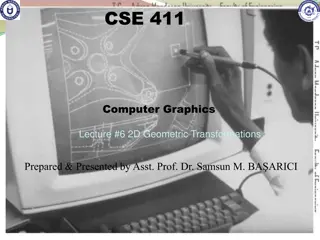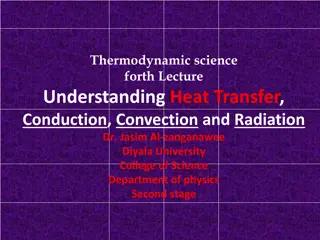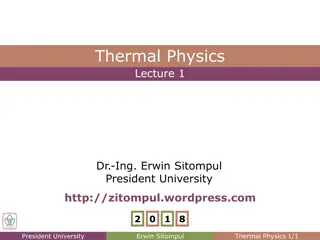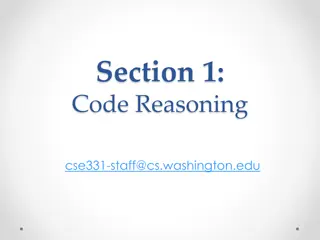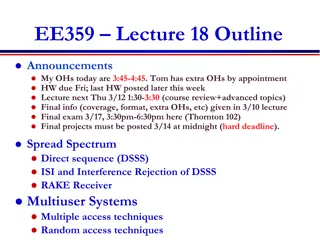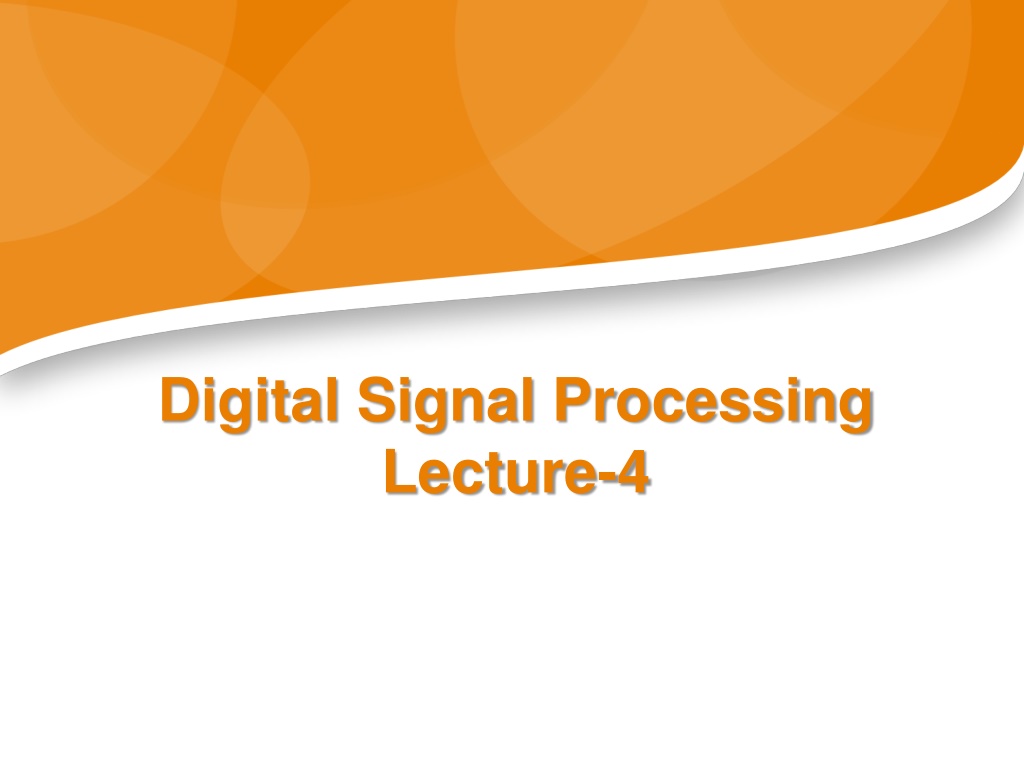
Understanding Digital Signal Processing Filters
Explore the fundamental concepts of digital signal processing filters, including different filter types like low-pass, high-pass, and band-pass filters. Learn about cutoff frequencies, bandwidth, and the characteristics of real versus ideal filters.
Download Presentation

Please find below an Image/Link to download the presentation.
The content on the website is provided AS IS for your information and personal use only. It may not be sold, licensed, or shared on other websites without obtaining consent from the author. Download presentation by click this link. If you encounter any issues during the download, it is possible that the publisher has removed the file from their server.
E N D
Presentation Transcript
Digital Signal Processing Lecture-4
Overview Filters Common Filter Types Analog vs. Digital Filters Difference Equation Difference Equation Diagram Elements Nonrecursive Difference Equation Diagrams Recursive Difference Equation Diagrams Impulse Response Step Response
Filters Filters change a signal s characteristics by selectively removing some of its frequency elements. A low pass filter, for example, removes the high frequency components of a signal, but components. passes low frequency It does this because the filter s gain, the amplification factor it applies to an input, varies with frequency. 3
Filters For a low pass filter, the gains are highest at low frequency and much lower at high frequency. A high pass filter has exactly the opposite shape: its gains are highest at high frequency and lowest at low frequency. The pass band of a filter determines the range of frequencies that are passed. The stop band of the filter determines the range of frequencies that are strongly attenuated. 4
Filters Cutoff Frequency A filter is considered to pass signals at frequencies where the filter s gain exceeds 0.707 of its maximum gain. The frequency or frequencies where the gain equals 0.707 of the maximum gain are called the cut-off frequencies of the filter. Since 20log0.707 = -3 dB, they are also called 3 dB frequencies. 5
Filters Bandwidth The bandwidth of a low pass filter is the range of frequencies from 0 to the 3 dB frequency. For a high pass filter, the bandwidth is the range of frequencies from the 3 dB frequency to half the sampling frequency. For band pass filters, the bandwidth is the distance in Hz between the cut-off frequencies. 6
Common Filter Types Low Pass Filter _____ Real Filter .... Ideal Filter 7
Common Filter Types High Pass Filter _____ Real Filter .... Ideal Filter 8
Common Filter Types Band Pass Filter _____ Real Filter .... Ideal Filter 9
Common Filter Types Band Stop or Notch Filter _____ Real Filter .... Ideal Filter 10
Filters Roll-Off Another important feature of a filter is its roll-off. This characteristic determines how quickly the gain drops outside the pass band. The higher the order of a digital filter, defined by the number of coefficients needed to specify it, the steeper the slope, and the higher the quality of the filter is said to be. 11
Filters Gain A filter s gain at a certain frequency determines the amplification factor that the filter applies to an input at this frequency. A gain may have any value. In the pass band region, filter s gain is high. In the stop band region, filter s gain is low. 12
Filters Gain The cutoff frequency of the filter occurs when the gain is 1 2~0.707 ?? 70.7% A gain in dB is calculated as ???? ?? = 20??? ???? 13
Filters Bandwidth Example-1: Find the bandwidth of the band pass filter. The edges of the pass Band occur where the Gain equals 0.707. The bandwidth of the Filter is BW = FH - FL BW = 4000 - 2000 BW = 2000 Hz 14
Square Wave A square wave can be constructed from multiple sine waves at different frequencies. The sine waves added in addition to the fundamental frequency are called harmonics. A square wave has harmonics at odd multiples of the fundamental frequency. 15
Square Wave As higher harmonics are added, the result gets closer to an ideal square wave, which contains infinite harmonics. sin(angle) + sin(3*angle)/3 + sin(5*angle)/5 + sin(7*angle)/7 + ... 16
Effects of Low Pass Filters Each filter type has a unique effect on an input signal. Low pass filters tend to smooth signals by averaging out sudden changes. 17
Effects of High Pass Filters Each filter type has a unique effect on an input signal. High pass filters tend emphasize sharp transition. 18
Analog vs. Digital Filters Filters may be implemented in either analog or digital form. Analog filters are defined in hardware, while digital filters are defined in software. In general, digital filters are much less susceptible to noise and component variation than are analog filters. Furthermore, digital filter re-design is simply a matter of editing a list of coefficients, while analog re-design requires building an entirely new circuit. 20
Difference Equation A difference equation is one way to specify a filter or system. It may be presented in equation or diagram form. The general form of a difference equation is a0y[n] + a1y[n-1] + a2y[n-2] + + aNy[n-N] = b0x[n] + b1x[n-1] + b2x[n-2] + + bMx[n-M] The akand bkweightings are called filter coefficients. Generally difference equation has N+1 ak coefficients and M+1 bk coefficients. N is the past output required, also referred as a filter order. M is the number of past input required. The equation defines how each new output y[n] is obtained. In general, a0is assumed to be one. 21
Difference Equation The general form of a difference equation is a0y[n] + a1y[n-1] + a2y[n-2] + + aNy[n-N] = b0x[n] + b1x[n-1] + b2x[n-2] + + bMx[n-M] The compact form of the recursive difference equation is In the above equation, both inputs and outputs are needed to compute a new output, so the difference equation is said to be recursive. 22
Difference Equation When only inputs are needed to compute a new output, the difference equation is said to be non-recursive, that is, y[n] = b0x[n] + b1x[n-1] + b2x[n-2] + + bMx[n-M] The compact form of the non-recursive difference equation is 23
Difference Equation Example-2: A filter has a difference equation y[n] = 0.5y[n-1] + x[n] a. Is this a recursive or non-recursive difference equation? b. Identify all ak and bk coefficients. c. If the input x[n] is u[n], find 5 samples of the output y[n]. Solution a. The equation is recursive as it depends on a past output y[n-1] b. Since y[n] 0.5y[n-1] = x[n], therefore a0 = 1, a1 = -0.5, b0 = 1 c. y[n] = 0.5y[n-1] + x[n] When n = 0, y[0] = 0.5y[0-1] + x[0] = 0.5(0) + 1 = 1 When n = 1, y[1] = 0.5y[1-1] + x[1] = 0.5(1) + 1 = 1.5 When n = 2, y[2] = 0.5y[2-1] + x[2] = 0.5(1.5) + 1 = 1.75 When n = 3, y[3] = 0.5y[3-1] + x[3] = 0.5(1.75) + 1 = 1.875 When n = 4, y[4] = 0.5y[4-1] + x[4] = 0.5(1.875) + 1 = 1.9375 Y[n] = {1, 1.5, 1.75, 1.875, 1.9375} 24
Difference Equation Y[n] = {1, 1.5, 1.75, 1.875, 1.9375} 25
Difference Equation Diagram Elements Delay Element 26
Difference Equation Diagram Elements Coefficient Multiplier Element 27
Difference Equation Diagram Elements Summer Element 28
Nonrecursive Difference Equation Diagram The general form of the nonrecursive difference equation is y[n] = b0x[n] + b1x[n-1] + b2x[n-2] + + bMx[n-M] It can be schematically presented as 29
Finite Word Length Effects When difference equations are implemented by a computer, quantization means that filter coefficients cannot be represented perfectly. This means that filter behavior will not match the design exactly. Furthermore, computer arithmetic is always subject to rounding and truncation errors, again due to the limited number of bits available. All of these effects are called finite word length effects. 30
Nonrecursive Difference Equation Diagram In order to reduce quantization error of filter s coefficient one strategy is to break higher order filter into second order chunks Figure: Cascaded second order nonrecursive filter sections 31
Nonrecursive Difference Equation Diagram Example-3: Draw a diagram for the difference equation y[n] = 0.5x[n] + 0.4x[n-1] - 0.2x[n-2] Solution 32
Nonrecursive Difference Equation Diagram Example-4: Write the difference equation of the following diagram. Solution y[n] = x[n] - 0.3x[n-2] + 0.7x[n-3] 33
Recursive Difference Equation Diagram The general form of a recursive difference equation is a0y[n] + a1y[n-1] + a2y[n-2] + + aNy[n-N] = b0x[n] + b1x[n-1] + b2x[n-2] + + bMx[n-M] 34
Recursive Difference Equation Diagram Example-5: Draw a direct form I diagram for the following recursive difference equation y[n] + 0.5y[n-2] = 0.8x[n] + 0.1x[n-1] - 0.3x[n-2] Solution 35
Recursive Difference Equation Diagram Example-6: Write the difference equation of the following diagram. Solution y[n] + 0.5y[n-2] = 0.8x[n] + 0.1x[n-1] - 0.3x[n-2] 36
Recursive Difference Equation Diagram In direct form I realization, calculation for output y[n] require M + 1 input states N output states M + N + 1 coefficient multiplications M + N additions When more than 2 or 3 delays are needed, this realization is very sensitive to the finite word length effects. 37
Recursive Difference Equation Diagram Recursive filters have an alternative representation, called direct form 2, that has certain advantages for implementation. This representation is defined by the pair of equations w[n] = x[n] a1w[n-1] a2w[n-2] aNw[n-N] y[n] = b0w[n] + b1w[n-1] + b2w[n-2] + + bMw[n-M] 38
Recursive Difference Equation Diagram Transpose of the direct form 2 realization is an another popular implementation model. 39
Recursive Difference Equation Diagram Example-7: Write the difference equation of the following diagram. The output of the bottom summer is 0.1x[n] 0.3y[n] The output of the middle summer is 0.1x[n-1] 0.3y[n-1] + 0.2x[n] 0.2y[n] The final out top summer is y[n] = 0.1x[n-2] 0.3y[n-2] + 0.2x[n-1] 0.2y[n-1] + 0.8x[n] 40
Impulse Response The impulse response h[n] is an important way of characterizing a filter or system. By definition, it is the system s response to an impulse function input [n]. 41
Impulse Response For a musical instrument like a piano, an impulse response corresponds to the note obtained by striking a single key. 42
Impulse Response The impulse response may be calculated from a system s difference equation. The impulse function [n] substitutes for the input x[n] The impulse response h[n] substitutes for the output y[n] 43
Impulse Response For a non-recursive system, the impulse response is h[n] = b0 [n] + b1 [n-1] + b2 [n-2] + + bM [n-M] For a recursive system, the impulse response is h[n] = a1h[n-1] a2h[n-2] aNh[n-N] + b0 [n] + b1 [n-1] + b2 [n-2] + + bM [n-M] 44
Impulse Response Because non-recursive systems do not rely on past outputs, they have finite impulse responses, which return to zero after a finite number of samples have elapsed. Recursive systems, on the other hand, have infinite impulse responses, because each new output depends on past outputs as well as inputs. For causal systems, both non-recursive and recursive, the impulse response h[n] is zero for n < 0. 45
Impulse Response Example-8: Find the first six samples of the impulse response h[n] for the difference equation Y[n] 0.4y[n-1] = x[n] x[n-1] Solution The impulse response of the difference equation is h[n] 0.4h[n-1] = [n] [n-1] So the first six samples of the impulse response are h[0] = 1 h[3] = -0.096 h[1] = -0.6 h[4] = -0.0384 h[2] = -0.24 h[5] = -0.01536 46
Impulse Response So the first six samples of the impulse response are h[0] = 1 h[3] = -0.096 h[1] = -0.6 h[4] = -0.0384 h[2] = -0.24 h[5] = -0.01536 h[n] = [1, 0.6, -0.24, -0.096, -0.0384, -0.01536] 47
Impulse Response Example-9: write the difference equation whose impulse response is shown in the figure. Solution The impulse response can be written as a sum of impulse functions. h[n] = [n] + 0.8 [n-1] + 0.2 [n-2] The difference equation is y[n] = x[n] + 0.8x[n-1] + 0.2x[n-2] 48
Impulse Response Example-10: The input signal x[n] and impulse response h[n] are shown in the figures. Find the output y[n] by breaking the input signal into impulse functions and finding the response to each. 49
Impulse Response Y[n] = 3h[n] + 2h[n-1] + h[n-2] 50






